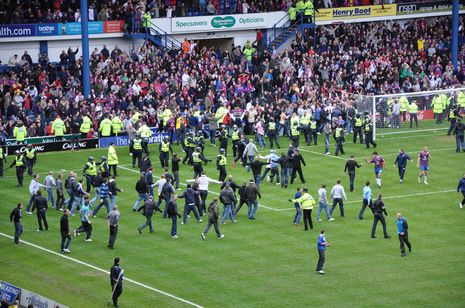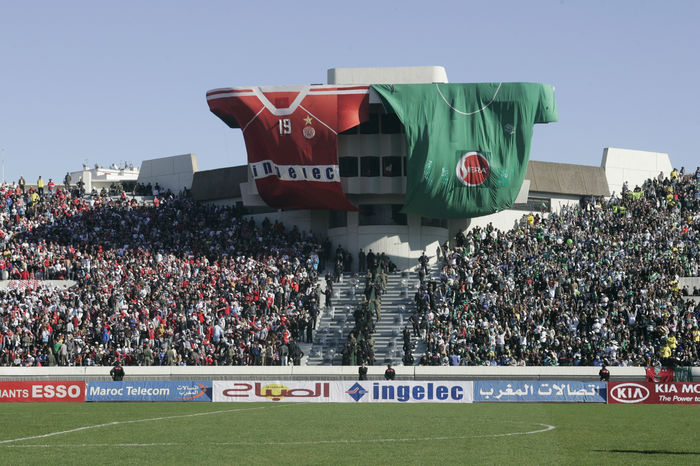Fan violence in France: understanding events and what it means for football
With the return of supporters to stadiums and recent unsavoury scenes in the French top tier, Jojo Jenner discusses physical fan violence and its prevalence in the modern game

On the evening of Sunday 22nd August, Dimitri Payet picked himself up from the floor, grabbed an orange bottle at his feet, and threw it back into the crowd. He turned to another bottle lying on the floor metres away and did the same again. Marseille’s players had been targeted with objects thrown from Nice’s home support throughout the game, but Payet’s 75th minute retaliation roused supporters to storm the pitch. The resulting brawls were spectacularly chaotic and broke out between fans, players, and staff alike. Reports would later emerge of injuries to Marseille players Payet, Matteo Guendouzi and Luan Peres, whilst the club’s fitness coach Pablo Fernandez has been suspended for punching a Nice fan.
Disciplinary proceedings are still ongoing, but Nice’s subsequent match against Bordeaux (28/08) was played behind closed doors and at least five fans have now been arrested. Returning to the game, referee Benoit Bastien took the Nice players back out onto the pitch sometime later in what proved to be a farcical attempt to restart the match, fully aware that irate Marseille manager Jorge Sampaoli had already led his players on to their team coach.
“Not only should fan attacks be seen in the context of football’s history, but also as a part of wider societal trends”
The final score was recorded as a 3-0 win for Nice due to Marseille’s refusal to finish the game, but assigning blame to the away side gives the frankly ridiculous impression that fans can simply storm the pitch to claim a win for their team whenever suits. Closely studied, the footage will reveal individual misdemeanours that deserve punishment, such as Payet’s reaction. The footballing world, however, needs to step back and acknowledge the scenes as more than just “crowd trouble”.
Fan violence in football is nothing new. Hooliganism, ultra culture, and multiple other names for aggressive behaviour patterns are widespread across the global landscape of football. In this same fixture back in 2019, the match was suspended for ten minutes halfway through the first half, as homophobic banners and chants were evident in the stands. Meanwhile, Marseille’s first game of this season was also affected by bottles thrown from the crowd, as they stormed to a 3-2 win coming from behind against Montpellier.
Historically, a pig’s head, bananas, and cups are among objects to have been thrown from various stands and, in each case, the conclusion is swiftly made that it was the responsibility of a few idiots who ‘are not real football fans’. The fact that recent racist abuse and missiles hurled at Raheem Sterling by Hungary’s fascist dictator-enabled, neo-nazi ultra group looks like it might receive a similar ‘one or two bad apples’ treatment by FIFA and UEFA is symptomatic of football’s tendency to dismiss terrifying violence as isolated affairs.
“Brave, outspoken young men performing for the entertainment of the masses have had their progressive attitudes weaponised against them”
Not only should fan attacks be seen in the context of football’s history, but also as a part of wider societal trends. People might have stormed pitches before, but this is the first occasion since the reopening of stadiums. Whilst closed, reports estimated a 48% increase in discriminatory abuse aimed at players on social media. As demonstrated after England’s defeat in the Euro 2020 final, fans increasingly latch onto the opportunity to scapegoat individuals, especially Black players.
The development of such horrific behaviours was largely confined to the online sphere for 2020 and much of 2021, but the post-match ritual of abusing players poses a very real threat on football’s return to stadia. Reachable DMs and unmoderated comment sections provide increasingly open access to professional footballers online, breaking down the decades-old divide between player and fan. How big can the jump be from virtual threats to physical violence?
Political allegiance is at the heart of some of the world’s most heated footballing rivalries, and Nice’s conflict with Marseille introduces an element of right against left respectively. Where inhibition boundaries are being removed between players and fans, politicians are digging trenches. England’s national men’s team were infamously criticised by home secretary Priti Patel, who described their taking of the knee as “gesture politics”. Although booing of the action largely dissipated throughout the tournament, it was clear after the final that these players were on thin ice with their relatively abusive fan base. Brave, outspoken young men performing for the entertainment of the masses have had their progressive attitudes weaponised against them, putting their own safety at risk.
Without emotion, football becomes utterly meaningless. People need to care and fan culture revolves around the notion that every weekend so many people pay some degree of attention to the game. However, this passion, in a manner almost unique to football, seems to develop into a sense of entitlement amongst fans; an entitlement to victory, to performance, and to abuse when either of these components are not delivered. Upon arriving at the office, a banker must not feel under threat to perform exceptionally or face physical violence; nor must a teacher, doctor, delivery driver and nor must a professional footballer. Whether there is a true long-term threat to player safety ahead remains to be seen but, given the disposability of income in football, failing to invest in appropriate precautions is not a mistake clubs can afford to make.
As the home fans crashed through the advertising hoardings from the ‘Populaire Sud’ two weeks ago, they crumpled the illusion of safety for athletes trying to perform at their place of work. In an ever polarised political landscape, football will always try to separate itself from reality; the threat to physical safety, however, has the potential to be very real indeed.
 Interviews / You don’t need to peak at Cambridge, says Robin Harding31 December 2025
Interviews / You don’t need to peak at Cambridge, says Robin Harding31 December 2025 Comment / What happened to men at Cambridge?31 December 2025
Comment / What happened to men at Cambridge?31 December 2025 News / Unions protest handling of redundancies at Epidemiology Unit30 December 2025
News / Unions protest handling of redundancies at Epidemiology Unit30 December 2025 News / Varsity’s biggest stories of 202531 December 2025
News / Varsity’s biggest stories of 202531 December 2025 News / Downing investigates ‘mysterious’ underground burial vault 29 December 2025
News / Downing investigates ‘mysterious’ underground burial vault 29 December 2025










